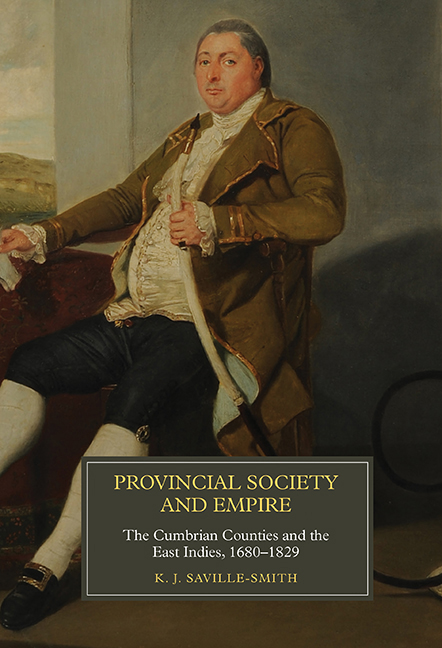Book contents
- Frontmatter
- Contents
- List of Illustrations
- Acknowledgements
- List of Abbreviations
- Glossary
- Chapter 1 The Provincial World and Global Encounters
- Chapter 2 Cumbrian Contexts, Patterns and Lives
- Chapter 3 Why Go to the East Indies?
- Chapter 4 ‘Passage to India’
- Chapter 5 Returning and Returns
- Chapter 6 Conclusion: ‘Use of Globes’
- Appendix A East Indies Enumerated Cumbrian Men
- Appendix B East Indies Enumerated Cumbrian Women
- Appendix C East Indies Women, Associated Cumbrian Men and Their Children
- Appendix D Hudleston, Kin Connections and the East Indies
- Appendix E East Indies connections of the Winders, Stephensons and Fawcetts
- Appendix F East Indies connections of the Braddylls, Wilsons and Gales
- Appendix G Kin Connections of Catherine Holme
- Appendix H Kin Connections of Thomas Cust
- Bibliography
- Index
- Miscellaneous Endmatter
Chapter 5 - Returning and Returns
Published online by Cambridge University Press: 18 April 2018
- Frontmatter
- Contents
- List of Illustrations
- Acknowledgements
- List of Abbreviations
- Glossary
- Chapter 1 The Provincial World and Global Encounters
- Chapter 2 Cumbrian Contexts, Patterns and Lives
- Chapter 3 Why Go to the East Indies?
- Chapter 4 ‘Passage to India’
- Chapter 5 Returning and Returns
- Chapter 6 Conclusion: ‘Use of Globes’
- Appendix A East Indies Enumerated Cumbrian Men
- Appendix B East Indies Enumerated Cumbrian Women
- Appendix C East Indies Women, Associated Cumbrian Men and Their Children
- Appendix D Hudleston, Kin Connections and the East Indies
- Appendix E East Indies connections of the Winders, Stephensons and Fawcetts
- Appendix F East Indies connections of the Braddylls, Wilsons and Gales
- Appendix G Kin Connections of Catherine Holme
- Appendix H Kin Connections of Thomas Cust
- Bibliography
- Index
- Miscellaneous Endmatter
Summary
Near this place lye the remains of John Braddyll, Esq., descended from an ancient family long seated at Portfield and Conishead, in Lancashire, who from his youth traversed the oceans of Europe and the Indies as a merchant, and having made a handsome fortune, the due reward of honest industry, and learned therewith to be content, he retired to this village, and enjoyed the fruits of his labour with temperance and moderation. Born at Conishead, 1695. Died at Carshalton, 13 May, 1753, aged 58 – Memorial in Tower, All Saints Carshalton, Surrey.
The splendid Indian Pagoda, recently presented to the [Carlisle] Museum, with so much munificence, by Sir Simon Heward, was the theme of general admiration and wonder – Carlisle Journal, 1842.
This chapter is about the legacy of East Indies sojourns. It traces the pattern of bodily return, or failure to return, among the Cumbrian women and men who went to the East Indies. It explores the financial and social outcomes for sojourners and their families after often years of physical separation and emotional and material investment in East Indies ventures. It is about how returning Cumbrians reinserted themselves and expressed their success in the Cumbrian world. It also considers how the East Indies infiltrated the fabric of provincial Cumbria in civil society, its politics and the day-to-day institutions of local authority.
At the heart of those processes was a dynamic interplay between place attachment, identity and expressions of success. As previous chapters have shown, going to the East Indies was fundamentally about returning and returns. Yet as sojourners prepared, and were prepared for the East Indies, not coming home was as probable as returning. Financial failure was a constant anxiety. Returning and returns, therefore, cannot be considered without giving attention to the issue of those who did not return to Cumbria. Consequently, the discussion starts with the pattern of bodily return to Cumbria. It notes that some returning sojourners resided outside of Cumbria when they returned to the British Isles. It notes, too, how the cycle of aspiration, passage and return was interrupted for many by death. It is in the context of death and the way in which Cumbrian sojourners were memorialised, that issues of Cumbrian attachment and detachment associated with the East Indies is initially explored.
- Type
- Chapter
- Information
- Provincial Society and EmpireThe Cumbrian Counties and the East Indies, 1680–1829, pp. 131 - 166Publisher: Boydell & BrewerPrint publication year: 2018



